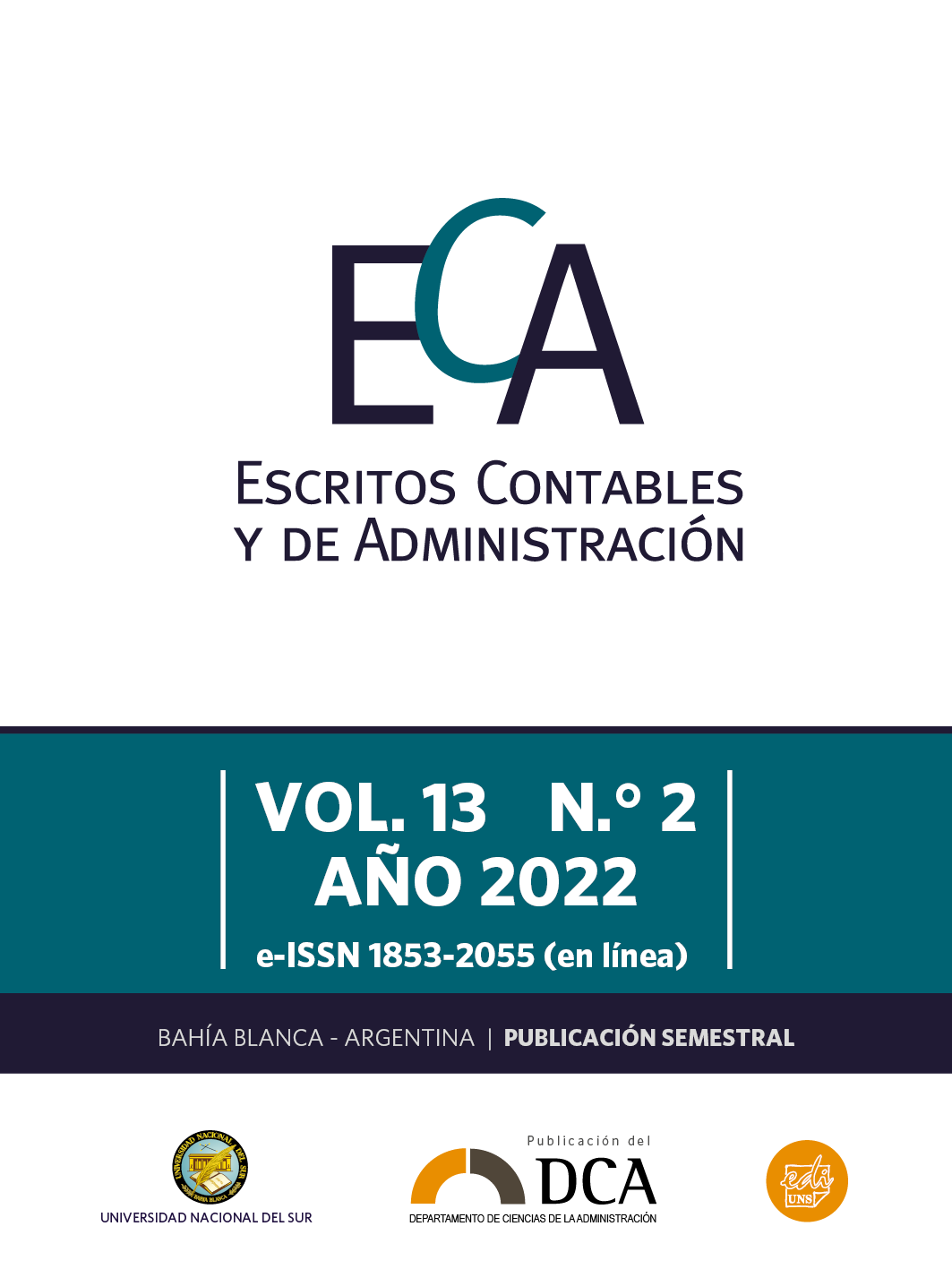Social sustainability and architecture: a systematic literature review
DOI:
https://doi.org/10.52292/j.eca.2022.3063Keywords:
social sustainability, architecture, citizen participation, culture, accessibilityAbstract
The social dimension of architecture has not had great development, unlike the environmental and economic ones. For this reason, the objectives of this article are: (1) to analyze the evolution of publications on social sustainability in architecture, through a systematic review of the literature, and (2) to summarize the main contributions of the most outstanding works. From the bibliometric analysis it can be identified that it is a topic of current study, with 75 % of the works published in the last seven years. On the other hand, when carrying out the content analysis, three important edges or themes are detected when defining sustainable architecture in its social aspects: citizen participation, culture and accessibility. Also, different indicators and tools used from the administration that can contribute to its measurement and monitoring are identified.
Downloads
References
Abdullah, F., Basha, B. y Soomro, A. R. (2017). Sustainable heritage: Analytical study on the viability of adaptive reuse with social approach, case study of Asia heritagerow, Kuala Lumpur. Advanced Science Letters, 23(7), 6179-6183. https://doi.org/10.1166/asl.2017.9231
Al-Jokhadar, A. y Jabi, W. (2017). Applying the vernacular model to high-rise residential development in the Middle East and North Africa. International Journal of Architectural Research (ArchNet-IJAR), 11(2), 175-189. https://www.archnet.org/publications/12017
Alwah, A. A. Q, Li, W., Alwah, M. A. Q. y Shahrah, S. (2021). Developing a quantitative tool to measure the extent to which public spaces meet user needs, Urban Forestry y Urban Greening, 62. https://doi.org/10.1016/j.ufug.2021.127152
Akadiri, P. O., Chinyio, E. A. y Olomolaiye, P. O. (2012). Design of A Sustainable Building: A Conceptual Framework for Implementing Sustainability in the Building Sector, Buildings, 2(2), 126-152. https://doi.org/10.3390/buildings2020126
Andersen, B. y Røe, P. G. (2017). The social context and politics of large scale urban architecture: Investigating the design of Barcode, Oslo. European Urban and Regional Studies, 24(3), 304-317. https://doi.org/10.1177/0969776416643751
Andersson, B. y Gromark, S. (2020). AIDAH-Editors’ post scriptum. En B. Andersson y S. Gromark (eds.), Architecture for Residential Care and Ageing Communities: Spaces for Dwelling and Healthcare (pp. 279-281). Routledge. https://doi.org/10.4324/9780429342370-25
Arenghi, A., Garofolob, I. y Laurìa, A. (2016). On the relationship between ‘universal’ and ‘particular’ in architecture. Studies in Health Technology and Informatics, (229), 31-39. https://www.researchgate.net/publication/307210480_On_the_Relationship_Between_’Universal’_and_’Particular’_in_Architecture
Bacon, N. y Caistor-Arendar, L. (2014). Measuring social sustainability in Sutton. http://www.sociallife.co/media/files/Sutton_Social_Sustainability_Nov14.pdf
Baumanova, M. (2020). Urban kinaesthetic heritage and production of social sustainability. Journal of Archaeological Science: Reports, 32, 102445. https://doi.org/10.1016/j.jasrep.2020.102445
Berkeley-Group y UKGBC (2012). Practical How-to Guide: How to Use a Social Sustainability Framework. London.
Brown, J. e Isaacs, D. (1994). Merging the best of two worlds the core processes of organizations as communities. En P. Senge, A. Kleiner, C. Roberts, R. Ross y B. Smith (eds.), The fifth discipline fieldbook: strategies and tools for building a learning organization (pp. 508-517). Doubleday Currency Publications.
Capolongo, S., Gola, M., Di Noia, M., Nickolova, M., Nachiero, D., Rebecchi, A. y Buffoli, M. (2016). Social sustainability in healthcare facilities: a rating tool for analyzing and improving social aspects in environments of care. Annali dell’Istituto superiore di sanita, 52(1), 15-23. https://pubmed.ncbi.nlm.nih.gov/27033614/
Ceylan, S. y Soygeniş, M. D. (2019). A design studio experience: impacts of social sustainability. Archnet-IJAR: International Journal of Architectural Research, 13(2), 368-385. https://doi.org/10.1108/arch-02-2019-0034
Couret, D. G., Santos, A. H., Calheiros, I. D. y Céspedes, L. V. V. (1998). From a scholar city to a solar city. Renewable energy, 15(1-4), 457-460. https://doi.org/10.1016/s0960-1481(98)00204-3
Department of Sustainability and Environment. (2005). Effective engagement: Building relationships with community and other stakeholders, Book 1: An introduction to engagement, Version 3. Melbourne: Victorian Government Department of Sustainability and Environment.
Durukan, A., Beşir, Ş. E., Altuntaş, S. K. y Açıkel, M. (2021). Evaluation of sustainability principles in adaptable re-functioning: Traditional residences in Demirel Complex. Sustainability, 13(5), 2514, 1-23. https://doi.org/10.3390/su13052514
Elsayed, H. A., AboWardah, E. S. y Ramadan, M. G. (2019). Traditional Market Design towards Cohesion between Social Sustainability and Bioclimatic Approach. IOP Conference Series: Materials Science and Engineering, 471(7), 072002. https://doi.org/10.1088/1757-899x/471/7/072002
Fowles, B. (2012). Transformative architecture: A synthesis of ecological and participatory design. En W. Fox (Ed.), Ethics and the built environment (pp. 118-130). Routledge. https://www.taylorfrancis.com/chapters/edit/10.4324/9780203130513-16/transformative-architecture-synthesis-ecological-participatory-design-bob-fowles
Gibberd, J. (2003). Integrating Sustainable Development into Briefing and Design Processes of Buildings in Developing Countries: An Assessment Tool. [Tesis de doctorado, University of Pretoria (UP)]. http://hdl.handle.net/2263/25525
Hatipoglu, H. K. e Ismail, S. H. (2019). Flexibility: From Tent to Modern Houses in Turkey Evaluation and Guidelines. IOP Conference Series: Materials Science and Engineering, 471(8), 082070. https://doi.org/10.1088/1757- 899x/471/8/082070
Hobbs, J. J. (2017). Heritage in the lived environment of the United Arab Emirates and the Gulf region. ArchNet-IJAR: International Journal of Architectural Research, 11(2), 55. https://www.archnet.org/publications/12009
Ibrahim, I. (2020). Sustainable Courtyards: Practical Experience Potentials. In IOP Conference Series: Earth and Environmental Science, 588(3), 032088. https://doi.org/10.1088/1755-1315/588/3/032088
Janissek Muniz, R., Borges, N. y Bortoli, L. (18-19 de mayo, 2015). Gestão dos sinais fracos no contexto brasileiro: estado da arte. [ponencia]. 8◦ Congresso IFBAE. Gramado, Rio Grande do Sul, Brasil. https://ifbae.s3.euwest3.amazonaws.com/file/congres/2015_B204.pdf
Kearns, A., Whitley, E., Mason, P. y Bond, L. (2012). ‘Living the high life’? Residential, social and psychosocial outcomes for high-rise occupants in a deprived context. Housing Studies, 27(1), 97-126. https://doi.org/10.1080/02673037.2012.632080
Kim, S., & Kwon, H. A. (2018). Urban sustainability through public architecture. Sustainability, 10(4), 1249. https://www.mdpi.com/2071-1050/10/4/1249
Kitchenham, B. (2004). Procedures for performing systematic reviews: Joint Technical Report (Keele University Technical Report TR/SE-0401, NICTA Technical Report 0400011T.1). https://www.inf.ufsc.br/~aldo.vw/kitchenham.pdf
Kohler, N. (1999). The relevance of green building challenge: An observer’s perspective. Building Research & Information, 27(4-5), 309–320. https://doi.org/10.1080/096132199369426
Kóródy, A. y Vukoszávlyev, Z. (2014). Aspects of social sustainability in cases of building rehabilitations in Central Europe. Építés–Építészettudomány, 42(3-4), 287-333. https://doi.org/10.1556/eptud.42.2014.3-4.10
Kostourou, F. (2015). Configurational and morphological sustainability in social housing: The case of Cité Ouvrière. En Proceedings of the 10th International Space Syntax Symposium. Space Syntax Laboratory, The Bartlett School of Architecture. https://www.researchgate.net/publication/282504906_Configurational_and_morphological_sustainability_in_social_housing_The_case_of_Cite_Ouvriere_in_Mulhouse
Kucharczyk-Brus, B. (26-28 de junio, 2013). The implementation of the principles of sustainable development in the residential buildings of big housing estates from the socialist period. [ponencia]. Central Europe towards Sustainable Building Conference. Sustainable Building and Refurbishment for Next Generations. Praga, República Checa. http://www.cesb.cz/cesb13/proceedings/1_refurbishment/CESB13_1210.pdf
Lami, I. M. y Mecca, B. (2021). Assessing Social Sustainability for Achieving Sustainable Architecture. Sustainability (Switzerland), 13(1), 142. https://doi.org/10.3390/su13010142
Lobos, J. (2012). Arquitectura y derechos humanos. Revista AUS, (12), 14-17. https://doi.org/10.4206/aus.2012.n12-04
Lommerse, M. (2014). Working Together: Interior Architecture creating with the community. En Smith, D., Lommerse, M. y Metcalfe, P. (eds.). Perspectives on Social Sustainability and Interior Architecture (pp. 15-40). Springer. https://doi.org/10.1007/978-981-4585-39-2_2
Lommerse, M. [Marina Lommerse]. (s. f.). Inicio [Página de LinkedIn]. LinkedIn. Recuperado el 10 de abril de 2022 de https://www.linkedin.com/in/marina-lommerse-b46ab8a/
Mace, R. (1985). Universal design: Barrier free environments for everyone. Designers West, 33(1), 147-152.
Magnoli, G. C., Talbot, R. D., Atkins, R., Ferrari, G., Shah, K. M. y Chong, T. (2002). Re-building the social capital: Lessons from the city of Edinburgh. Advances in Architecture Series, 14, 663-673. https://www.witpress.com/elibrary/wit-transactions-on-ecology-and-the-environment/54/707
Manterola, C., Astudillo, P., Arias, E., Claros, N. y Mincir, G. (2013). Revisiones sistemáticas de la literatura. Qué se debe saber acerca de ellas. Cirugía española, 91(3), 149-155. https://doi.org/10.1016/j.ciresp.2011.07.009
Mehdinezhad, J. y Nabi, R. N. (2016). Investigating cultural and social sustainability in renovation and durability of vernacular buildings of İran’s architecture (case study: Bazaar of tabriz). IIOAB Journal, 7, 486-495. https://www.iioab.org/articles/IIOABJ_7.S4_486-495.pdf
Metcalfe, P. [Priya Metcalfe]. (s. f.). Inicio [Página de LinkedIn]. LinkedIn. Recuperado el 10 de abril de 2022 de https://www.linkedin.com/in/priya-metcalfe-269b5987/
Mitchel, K. (2010). Learning from Traces of Past Living: Courtyard Housing as Precedent and Project. En N. Rabbat (ed.). The Courtyard House: From Cultural Reference to Universal Relevance (pp. 223-238). Ashgate Publishing Limited, in association with the Aga Khan Program for Islamic Architecture.
Mortada, H. (2003). Traditional Islamic Principles of Built Environment. Routledge. https://doi.org/10.4324/9780203422687
Nuha, A. L. U. y Lukito, Y. N. (2018). Sustaining the Culture of the City: Architecture and Cosmology in the Mantingan Mosque and Cemetery Complex in Jepara. E3S Web of Conferences, 67, 04037. https://doi.org/10.1051/e3sconf/20186704037
Oliver, P. (2003). Dwellings: The Vernacular House World Wide. London: Phaidon Press Limited.
Olukoya, O. A. y Atanda, J. O. (2020). Assessing the Social Sustainability Indicators in Vernacular Architecture Application of a Green Building Assessment Approach. Environments - MDPI, 7(9), 67. https://doi.org/10.3390/environments7090067
Peters, T., y Halleran, A. (2020). How our homes impact our health: using a COVID-19 informed approach to examine urban apartment housing. Archnet-IJAR: International Journal of Architectural Research, 15(1), 10-27. https://doi.org/10.1108/arch-08-2020-0159
Pettinari, S., Perriccioli, M. y Rossi, M. (2011). Life architecture: Open and sustainable building for a strategic dwelling system. En M. Bodart y A. Evrard (Eds.), Architecture and Sustainable Development (vol. 2, pp.501-506). Presses universitaires de Louvain https://books.google.com.ec/booksid=KKZMp2kotAEC&printsec=copyright#v=onepage&q&f=false
Pilechi, P. y Taherkhani, P. (2011). Social sustainability in student dormitories. Procedia Engineering, 21, 59-64. https://doi.org/10.1016/j.proeng.2011.11.1987
Polese, M. y Stren, R. E. (eds.). (2000). The Social Sustainability of Cities. Diversity and the Management of Change. University of Toronto Press. https://doi.org/10.3138/9781442682399-002
Pomeroy, J. (2014). The Skycourt and Skygarden: Greening the Urban Habitat. First Edit. Routledge. https://doi.org/10.4324/9781315881645-8
Raeisi, I., Nezhad, A. K. y Hafezifar, M. (2010). Architectural Design Principles of Public Spaces Based on Social Sustainability Approach: A Case Study in Ardabil, Iran. Design Principles & Practice: An International Journal, 4(5). https://doi.org/10.18848/1833-1874/cgp/v04i05/37968
Ragette, F. (2003). Traditional Domestic Architecture of the Arab Region. Sharjah, UAE: American University of Sharjah.
Sakina, B. [Bunga Sakina]. (s. f.). Inicio [Página de LinkedIn]. LinkedIn. Recuperado el 10 de abril de 2022 de https://www.linkedin.com/in/bunga-sakina-b115a7a2/
Sakina, B. (2018). An assessment of sustainability in architecture based on sustainable building framework – Case study: Mesvara house, Yogyakarta, Indonesia. IOP Conference Series: Earth and Environmental Science, 195, 012093. https://iopscience.iop.org/article/10.1088/1755-1315/195/1/012086
Sakina, B. (2020). A study on crime prevention through environmental design concept application in a private house in Yogyakarta, Indonesia. IOP Conference Series: Earth and Environmental Science, 426(1), 012093. IOP Publishing. https://doi.org/10.1088/1755-1315/426/1/012093
Salameh, M. M., Touqan, B. A., Awad, J. y Salameh, M. M. (2021). Heritage conservation as a bridge to sustainability assessing thermal performance and the preservation of identity through heritage conservation in the Mediterranean city of Nablus. Ain Shams Engineering Journal. 13(2), 101553. https://doi.org/10.1016/j.asej.2021.07.007
Siláči, I. y Vitková, L. (2017). Public Spaces as the Reflection of Society and its Culture, IOP Conference Series: Materials Science and Engineering, 245(4), 042009. https://doi.org/10.1088/1757-899x/245/4/042009
Smith, D. [Dianne Smith]. (s. f.). Inicio [Página de LinkedIn]. LinkedIn. Recuperado el 10 de abril de 2022 de https://www.linkedin.com/in/dianne-smith-a7a4b915/
Smith, D. (2014). Interiors can address social justice: Fact or fiction. En: D. Smith, M. Lommerse y P. Metcalfe, P. (eds.). Perspectives on Social Sustainability and Interior Architecture (pp. 55-78). Springer. https://link.springer.com/chapter/10.1007/978-981-4585-39-2_4
Smith, D., Beeck, S., Lommerse, M. y Metcalfe, P. (2014). An introduction to social sustainability and interior architecture. En: D. Smith, M. Lommerse y P. Metcalfe, P. (eds.). Perspectives on Social Sustainability and Interior Architecture (pp. 1-11). Springer. https://doi.org/10.1007/978-981-4585-39-2_1
Soufiane, F., Said, M., y Atef, A. (2015). Sustainable urban design of historical city centers. Energy procedia, 74, 301-307. https://doi.org/10.1016/j.egypro.2015.07.612
Taylor, B. B. (1985). Contemporary Houses Traditional Values: Tunisia, Egypt, and Morocco. Zamana Gallery.
Vavik, T. (2011). Strategies for teaching universal design. En A. Kovacevic, W. Ion, C. McMahon, L. Buck y P. Hogarth (Eds.), DS 69: Proceedings of E&PDE 2011, the 13th International Conference on Engineering and Product Design Education. Institute of Design at Oslo School of Architecture and Design (AHO) https://www.designsociety.org/publication/30911/Strategies+for+Teaching+Universal+Design
Wan, L. y Ng, E. (2018). Evaluation of the social dimension of sustainability in the built environment in poor rural areas of China. Architectural Science Review, 61(5), 319-326. https://doi.org/10.1080/00038628.2018.1505595 Woodcraft, S. (2012). Social Sustainability and New Communities: Moving from Concept to Practice in the UK. Procedia - Social and Behavioral Sciences 68, 29–42. https://doi.org/10.1016/j.sbspro.2012.12.204
World Health Organization (WHO). (2010). The ICF: an overview. Center for Desease Control and Prevention. https://www.cdc.gov/nchs/data/icd/icfoverview_finalforwho10sept.pdf
Yang, B., Li, S. y Binder, C. (2016) A research frontier in landscape architecture: landscape performance and assessment of social benefits, Landscape Research, 41(3), 314-329. https://doi.org/10.1080/01426397.2015.1077944
Zarghami, E., Fatourehchi, D. y Karamloo, M. (2017). Impact of daylighting design strategies on social sustainability through the built environment. Sustainable Development, 25(6), 504-527. https://doi.org/10.1002/sd.1675
Published
How to Cite
Issue
Section
License
Copyright (c) 2022 Stefani Chavez, Lucía Sarro, Franco Finocchiaro

This work is licensed under a Creative Commons Attribution-NonCommercial 4.0 International License.
Aviso de derechos de autor
Aquellos autores/as que tengan publicaciones con esta revista, aceptan los términos siguientes:
- Los autores/as conservarán sus derechos de autor y garantizarán a la revista el derecho de primera publicación de su obra, el cual estará simultáneamente sujeto a la licencia Atribución-No Comercial 4.0 Internacional CC BY-NC 4.0.
- Los autores/as podrán adoptar otros acuerdos de licencia no exclusiva de distribución de la versión de la obra publicada (p. ej.: depositarla en un archivo telemático institucional o publicarla en un volumen monográfico) siempre que se indique la publicación inicial en esta revista.
- Se permite y recomienda a los autores/as difundir su obra a través de Internet (por ej.: en páginas web institucionales o personales) una vez publicado su trabajo, lo cual puede producir intercambios interesantes y aumentar las citas de la obra publicada (Véase El efecto del acceso abierto).





















